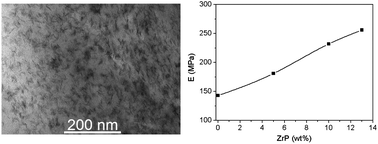Short side chain perfluorosulfonic acid membranes and their composites with nanosized zirconium phosphate: hydration, mechanical properties and proton conductivity
Abstract
Aqueous dispersions of a short side chain perfluorosulfonic acid

* Corresponding authors
a
Chemistry Department, University of Perugia, via Elce di Sotto 8, 06123 – Perugia, Italy
E-mail:
an.donnadio@libero.it
Fax: +39 75 5855566
Tel: +39 75 5855567
b SOLVAY SOLEXIS, viale Lombardia 20, 20021-Bollate, Milano, Italy
Aqueous dispersions of a short side chain perfluorosulfonic acid

 Please wait while we load your content...
Something went wrong. Try again?
Please wait while we load your content...
Something went wrong. Try again?
M. Pica, A. Donnadio, M. Casciola, P. Cojocaru and L. Merlo, J. Mater. Chem., 2012, 22, 24902 DOI: 10.1039/C2JM34958B
To request permission to reproduce material from this article, please go to the Copyright Clearance Center request page.
If you are an author contributing to an RSC publication, you do not need to request permission provided correct acknowledgement is given.
If you are the author of this article, you do not need to request permission to reproduce figures and diagrams provided correct acknowledgement is given. If you want to reproduce the whole article in a third-party publication (excluding your thesis/dissertation for which permission is not required) please go to the Copyright Clearance Center request page.
Read more about how to correctly acknowledge RSC content.
 Fetching data from CrossRef.
Fetching data from CrossRef.
This may take some time to load.
Loading related content
